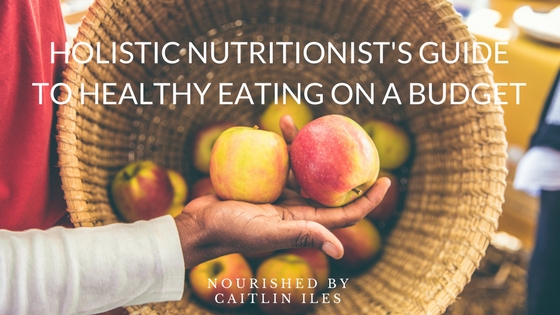Hi friend! I hope you’re having a wonderful day. Today I’m going to chat about some great ways to save money while eating a whole foods based diet.
Apart from rent, the majority of my income goes towards food and what I put in my body. I’m a firm believer in the idea that I can pay a little more now for quality food that nourishes my body or I can pay dividends in illness, quality of life, and medical bills later.
Since I have too many fun things I’d like to do in the future, it’s a no brainer that I’ll have to make sacrifices in terms of new clothes, gadgets, or meals out in order to become the healthiest possible version of myself. All that being said, I love a good deal and I love stretching my dollar as far as possible. Thank you to my mom and dad for teaching me how to shop a sale and find the sweetest deals 😉
Here are a few tips and tricks I’ve picked up along the way for eating clean on a smaller-than-desired budget.
1. Follow the EWGs Clean 15 and Dirty 12
In a perfect world I would be eating 100% organic 100% of the time. Unfortunately, that is just not feasible at this point in my life so I try to stick with buying produce that is most likely to contain the most pesticides in its organic form.
Things like apples, spinach, berries, greens, and certain squashes are heavily sprayed and even after washing, peeling, or soaking still contain high amounts of pesticides when tested, so if I can’t afford to buy them organic, I don’t. Shopping at Costco is one way to buy organic produce at a cheaper price-point.
I’m also a huge fan of chatting with your local farmers as they may be practicing organic principles, without the expensive designation! Check out this link for the full Clean 15 and Dirty Dozen list.
2. Buy in Bulk
I love buying in bulk. I’ve never been one of those people who cringes at spending a little bit more now to save in the future. In fact I’ve perfected a routine where I buy certain food items from certain places that ends up saving me big in the long run.
For example if I buy packs of canned coconut milk by the dozen then I end up paying only $1.17/can as opposed to $1.59-2.99/can. Considering the amount of coconut milk I go through, those few cents on the can add up to big savings every month. When you drink as much coconut milk as I do, it adds up quickly!
Note: I have since started using Real Thai 1L tetra packs of coconut milk typically available in the international foods aisle of Superstore in order to avoid the BPA in the cans.
I buy my organic, cold-pressed coconut oil at Costco for only $24/54oz (my brother saw the same exact brand for sale at a health food store for $40). Costco and wholesale supermarkets are great places to hunt for deals on produce that is part of the Clean 15.
Though Costco does require you purchase a membership, I find I can get a lot of business supplies, socks, kitchen utensils, etc. there at deeply discounted rates, making it totally worth the small yearly fee.
Other items that are worth buying in bulk are herbs and spices. Most health food stores or food co-ops sell various herbs and spices by the pound, usually quite a bit cheaper than if you were to buy a small amount. I pick the spices I use most often, such as turmeric, cinnamon, chili powder, cayenne, thyme, and paprika, and buy them in larger quantities. You can take a small amount out and store it in a glass jar and put the rest in the freezer until you need it, which keeps the spices nice and fresh for much longer.
Finally, I always check out the organic sections at Winners. They carry tons of health food store brands of cosmetics, organic foods, coconut oils, nut butters, and so much more, again at a very deep discount.
I recently found organic matcha green tea for $5.99/50g. If you’ve ever gone to a health food store you know that you’re likely going to end up paying upwards of $20/100g, so this was a sweet deal for someone who is as addicted to tea as I am.
3. Shop the Discount Produce Bin
Most grocery stores, produce-selling health food stores, and food co-ops typically do not sell their entire stock before either new stock comes in or it starts looking slightly less appealing to the consumer.
I always stock up on organic bananas at 50% off just because they’re turning slightly brown. Typically I’ll bring them home, peel them, cut them in half, set them out on a baking tray in the freezer until frozen through, then store in a produce bag.
I use these frozen bananas for smoothies and baking.
Other fruits and veggies will often go on sale as well, and if they’re slightly soft or going off, can be used to make soups, vinaigrettes, purees, smoothies, or used to flavour kombucha.
4. Don’t Waste Anything
That old adage “Waste not want not” may be totally clichéd, but it rings true even today. Say you roast a chicken for dinner, and use all the leftover meat for sammies, soups, or salads. Great first step.
But you can also take the chicken bones, throw them in a pot of water with your various kitchen scraps, such as garlic and onions peels and ends, bits of carrot and celery, kale stems, etc., some vinegar, and simmer away to make a nourishing and delicious bone stock. Check out my easy recipe right here!
Or say you made some roasted butternut squash for dinner. Don’t throw the seeds away! You can toast them with a little coconut oil and sea salt, or candy them with maple syrup, sea salt, and balsamic vinegar for a tasty treat.
Saving the “wasted” bits goes beyond just food scraps to glass jars that certain sauces, vinegars, or oils come in. If they come with a sturdy lid, I never throw glass jars away. I use them in place of plastic to make for a cheaper, and healthier, food storage option.
5. Shop at Farmer’s Markets or Join a CSA (Community Supported Agriculture)
Oftentimes buying direct from the farmer can be much cheaper than going through a grocery or health food store as you’re cutting out the middle man. Joining a CSA is also an excellent way to help support local farmers and be introduced to new, exciting, in-season foods!
Essentially when you join a CSA you pay one lump sum at the beginning of the season. This fee helps the farmers pay for their upfront costs in terms of planting and harvesting. In return for this payment, you typically receive a weekly box of produce containing the items that have ripened that week.
I was part of one in Toronto and it was absolutely amazing! It was through the CSA that I was introduced to two of my favourite foods: Jerusalem artichokes and duck eggs. To find out about CSAs in your area just google CSA + your city and you should find one quite readily.
6. Pay for Quality when it’s Worth It
Sometimes it is worth spending a little bit more to ensure a quality food item. The items I do not shy away from spending a little more on include: pasture raised eggs; organic or grassfed butter; organic, grassfed, or hormone/antibiotic free meats; wild-caught fish and seafood (go for sustainably harvested to help protect the ocean eco-systems!); and organic nuts and seeds (and their oils).
The reason I don’t mind spending a little bit more on the meats and fats I eat is that in animals (humans included), toxins are stored in their fat cells.
So say you’re eating a conventionally raised piece of beef for dinner. All the stress hormones, toxins from its feed, antibiotics, and synthetic hormones are going to go right into your belly and start messing with your own system. Nobody wants to eat poisoned food, but essentially when you’re eating animals raised on concentrated animal feeding operations (CAFOs), that’s what you’re getting.
Not only is the meat essentially poisoned, but by purchasing these meats you are supporting the absolutely abhorrent treatment of the animals who live there. These animals are fed unnatural diets, i.e. ruminants are fed grains; forced to stand knee deep in their own feces; shot full of antibiotics to ward off the illnesses caused by the first two things I mentioned; and are given hormones to make them grow bigger, faster.
I am by no means a vegetarian, but I think that all beings of creation deserve to be treated with dignity and respect, regardless of whether or not they end up on our plate or are kept as pets. As Gandhi said “You can judge a society by how it treats its weakest members” and I for one do not want to support a system that treats not only its animals, but also its humans, with such blatant disrespect. There. Rant over. 😉
But in all seriousness, if you are unfamiliar with the CAFO system of raising animals, I suggest you check out these resources so you can make an informed decision on the food you buy.
Well friend, those are my top six tips for eating healthy on a budget. And a slight rant on the evils of modern meat production. But c’est la vie.
To help put together your budget-friendly healthy shopping list make sure you check out my post on What a Nutritionist Buys at Costco right here. It’s packed with tons of great brands and sweet deals!
If you’re looking for a way to kick-start some healthy habits, self-love practices, and figure out which foods are keeping you feeling sluggish, bloated, or anxious then check out my new Learn to Love Your Healthy Self Nutrition Challenge! It’s a 28 day guided program (complete with online cooking classes, guided meditations, yoga classes, and Q & A sessions!!) to give you the tools & knowledge to make lasting habit changes to help improve your sleep, clear up your skin, improve digestion, & balance out your moods with just a little bit of time dedicated to your self care & nutrition every day.
You can check out all the information right here and if you sign up by midnight on Wednesday June 10th, you’ll get a special discount!I’ve already got a great group excited to start Monday, June 15th. You can read about all the details here.
Stay safe and take care of one another!
Cheers, Caitlin xo

How Can I Eat Healthy on a Budget?




Trackbacks/Pingbacks